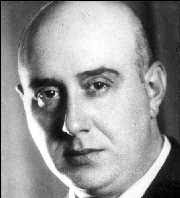
World Monuments Fund
An early Modernist structure designed by the Portuguese architect Luis Cristino da Silva and Jose Belard da Fonseca, the Teatro Capitólio opened in 1931 in Lisbon’s famed Parque Mayer theatre district. The building features numerous design and technical innovations, including a naturally lit performance hall and a roof terrace accessed by moving ramps for outdoor film screenings. Although the Teatro Capitólio is a nationally recognized landmark, it has been closed to the public since the 1980s and has since suffered unsympathetic alterations, water ingress, and delamination of its concrete and stucco exterior. Plans to raze the theater and replace it with a new performing arts center have recently been abandoned thanks largely to the work of a grassroots opposition movement, Citizens for Capitólio, which advocated for the restoration of the theater. The group nominated the site to the 2006 Watch, which drew international attention to the plight of the structure. Their aim is to restore the structure and use the project as a model for conserving other Modernism structures in Portugal. In 2009, the City Council of Lisbon announced a detailed plan to restore the Parque Mayer district and renovate the Teatro Capitólio. The first phase of the project to restore the Teatro Capitólio recently began.
The Teatro Capitólio’s visionary design heralded a new age of architectural expression for Portuguese architecture. Its construction made unprecedented advances in engineering technology, and is recognized as the first great Modern Movement building in Portugal. The Teatro Capitólio is an invaluable part of the country’s Modernist heritage and its history of cinema.



World Monuments Fund
During a May 2009 visit to New York, members of Citizens for Capitólio, a Lisbon-based watchdog group which has campaigned for Teatro Capitólio (1925-31) in Lisbon, took the opportunity to call in at World Monuments Fund, which had placed the building on their 2006 Watch list of endangered sites. During the informal meeting, they were able to brief WMF staff on recent progress to restore and rehabilitate the Capitólio.
Citizens for Capitólio was formed in direct response to a Lisbon City Council proposal in 2003 to demolish the structure (which had functioned simultaneously as theatre, cinema and vaudeville hall until its closure in the 1980s) and replace it with a new theater designed by Frank Gehry as part of a larger plan to redevelop the area. The nomination of the building by the group and its successful inclusion in the WMF list were instrumental in reversing the proposal. Awareness about the listing created by the media also helped to increase public support to save one of Portugal's most important 20th-century buildings.
Following an international competition in early 2009, an architectural team led by Portuguese architect Souza Oliveira was selected, and now a project to revive this iconic structure has begun!
The commencement of Phase One of the restoration on March 22, 2010 was a significant milestone in the uncertain journey of a somewhat misunderstood, but precious, architectural treasure. By August, asbestos and other hazardous materials had been removed; structures added to the building after its consruction had been removed; unsafe parts of the original building were demolished (and will be rebuilt); and a further assessment of the structural and material condition of the original building was undertaken.
This first phase of work has returned the building to its original profile. When fully completed in 2012, Teatro Capitólio will re-emerge with many original features and its bold Modernist lines restored, and as a new venue for entertainment in the 21st century.
August 15, 2010
Update on Teatro Capitólio
Posted by Fernando Jorge, Citizens for Capitólio

Cinema Treasures
Teatro Capitolio is located at Parque Mayer, an entertainment precinct in Lisbon which opened in 1922. Portuguese architect Luis Cristino da Silva (1896-1976) designed Capitolio in 1925-1929. The engineer Jose Belard da Fonseca (1899-1969) was responsible for the building’s adventurous reinforced concrete structure. When it opened to the public in 1931, it was an unprecedented statement in Portugal of the spirit of the modern world. The innovative entertainment venue combined a cinema / theatre hall with a roof-terrace for performances in the open. With its acclaimed pioneering functionalist architecture, Capitolio is an outstanding example from the early days of the Modern Movement in Europe.
The Capitolio is listed by the Portuguese State (1983) and registered in the Docomomo Iberico (1996).
The Capitolio closed in the 1980s and has since been left to ruin. Its restoration – long overdue – is being called for by the pressure group “Citizens for the Capitolio” together with the National Museum of Cinema, the National Museum of Theatre and Docomomo International.
The owner – the City Council of Lisbon – proposes its demolition and replacement with a new theatre designed by architect Frank O. Gehry.
The Teatro Capitolio has been selected by World Monuments Fund for the “World Monuments Watch – 100 Most Endangered Sites” list of 2006 (www.wmf.org). The forgotten but precious Capitolio – considered the first great Modern Movement building in Portugal – is in urgent need of rescue and attention.
Contributed by Fernando Jorge












































































2 comentários:
Mandem lá o edifício abaixo. Não há dinheiro para manter nada disto. Construam mas é um parque de estacionamento nessa zona que Lisboa bem precisa.
Provavelmente um parque de estacionamento (grátis) ficava melhor neste sítio.
Quem vai a teatros de qualquer maneira??
O que faz mesmo falta é mais espaços de estacionamento e com lugares mais largos adaptados aos automóveis do presente, como os SUV que são muito maiores (e mais confortáveis) que os "carrinhos" de cidade.
Para dinamizar mais a circulação automóvel nesta zona faz falta mais espaço estacionamento que não deve de ser desperdiçado em nostalgias patéticas.
Por mim, Lisboeta, mandem isso tudo abaixo e venham lugares gratuitos de estacionamento. É a solução mais económica e ficam os automobilistas a ganhar
Enviar um comentário